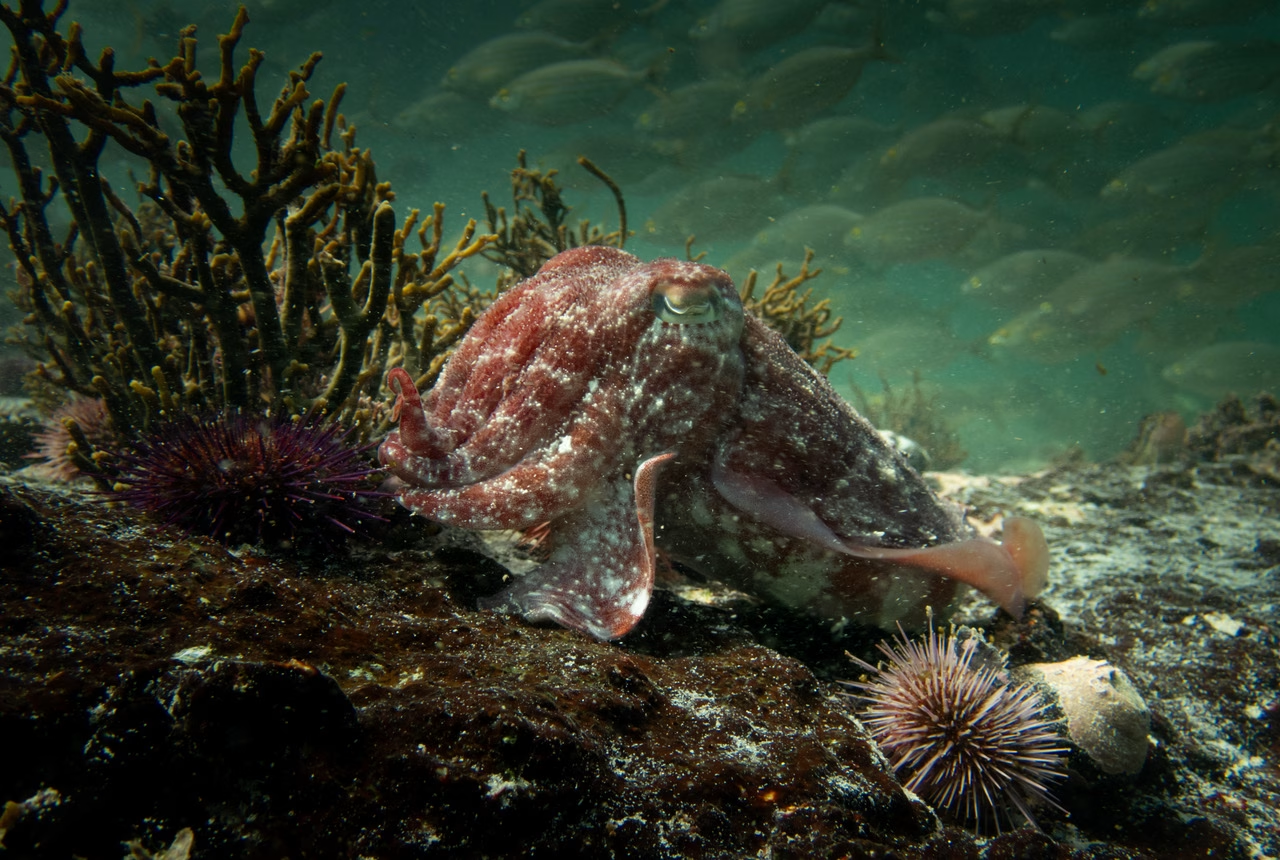What’s Your Name?
JANNES LANDSCHOFF
As a team, we have been working on the 1001 Seaforest Species project for several years. Some species are common, and we believe we know them well. Yet the idea of what is “well known” can be deceptive. Recently, I worked on the cephalopod group for the 1001 Seaforest Species app and website, which we are developing to showcase the remarkable diversity of life in and around the Great African Seaforest. The cephalopod group includes octopuses, cuttlefish and squid, and South Africa’s unique marine habitats are home to about 200 species of these – nearly a quarter of all the world’s cephalopod species. A few of these live in the kelp forest, and we have followed them for many years. Yet they never cease to surprise me.
Going through hundreds of pictures and observations of large cuttlefish from the past decade of Craig’s and my diving, I noticed peculiarities in colour patterns, body shapes and behaviours. We – and probably everyone else diving in the kelp forest – had been calling the largest cuttlefish the “Common” or “Patchwork” cuttlefish (Sepia vermiculata). We spent so much time with these animals, yet something about their identification felt strange. Following my instinct, I revisited field guides, online repositories and taxonomic literature, but couldn’t figure it out.

Identifying cuttlefish in the wild is tricky. They can change colour and shape in an instant, while most scientific descriptions are based on preserved specimens that have lost their colour and form. Key features used to distinguish species, such as the clubs and suckers on the tentacles, are hidden in a living animal. When these species were first described, sometimes centuries ago, biologists had no underwater cameras and were not diving. This creates a classic mismatch: the characteristics described in the literature often don’t align with our observations in the wild.
Then, one day, an otter became my unexpected assistant, handing me the missing clue. While tracking animals along the coast, we found the remains of its breakfast: a large cuttlefish, partially eaten but with the long tentacles and their clubs left behind. Several large cuttlefish live around Cape Town, and the species we often encounter in the kelp forest – the very one the otter had eaten – turned out not to be the Patchwork cuttlefish, as we had always assumed, but the Simon’s Town cuttlefish Sepia simoniana. This species has long tentacles lined with hundreds of tiny suckers on the clubs, which I could now see clearly for the first time. Thanks to the otter, I had the missing link, which made it possible to identify all the other pictures more confidently.
I was quite shocked. All these years, we had been using the wrong name for an animal we had spent so much time with and come to know intimately.
The remains of a Simon’s Town cuttlefish taken by a Cape clawless otter provided the missing link to correctly identify our live observations. Noticing the distinctive clubs with their tiny suckers led me to re-examine the entire photo library of cuttlefish from the area.
Left: A key feature of the Simon’s Town cuttlefish are its extremely long tentacles with a club full of tiny suckers, used to capture prey. The tentacles only shoot out when the animal strikes. The clubs at the tips, covered in hundreds of tiny suckers, are unique to this species — a deadly grip for crabs or fish.
Right: Under the microscope, the cuttlefish’s suckers reveal even finer detail: each rim is lined with tiny teeth. When the Simon’s Town cuttlefish strikes at a slippery fish, this microscopic armour leaves the prey little chance of escape.
I almost felt embarrassed and had to laugh when it sank in. And then I grew genuinely excited to look more closely at all the other cuttlefish species for the 1001 app. Were there more hidden identities waiting to be uncovered? One of the things I love most is figuring out species identifications in the water: learning what each animal is, sharing observations with friends and colleagues who share the passion, and eventually passing on not just the information but also the wonder of it all to others.
This is one of the real strengths of the 1001 Seaforest Species project. We are deeply grateful to carry it out, made possible through the support and trust of the Save Our Seas Foundation. The cuttlefish identification is a personal reminder of why I do this work. Because in the end, isn’t it important to call the ones we love and care for by their right name?
Photos by Dr Jannes Landschoff & Craig Foster.